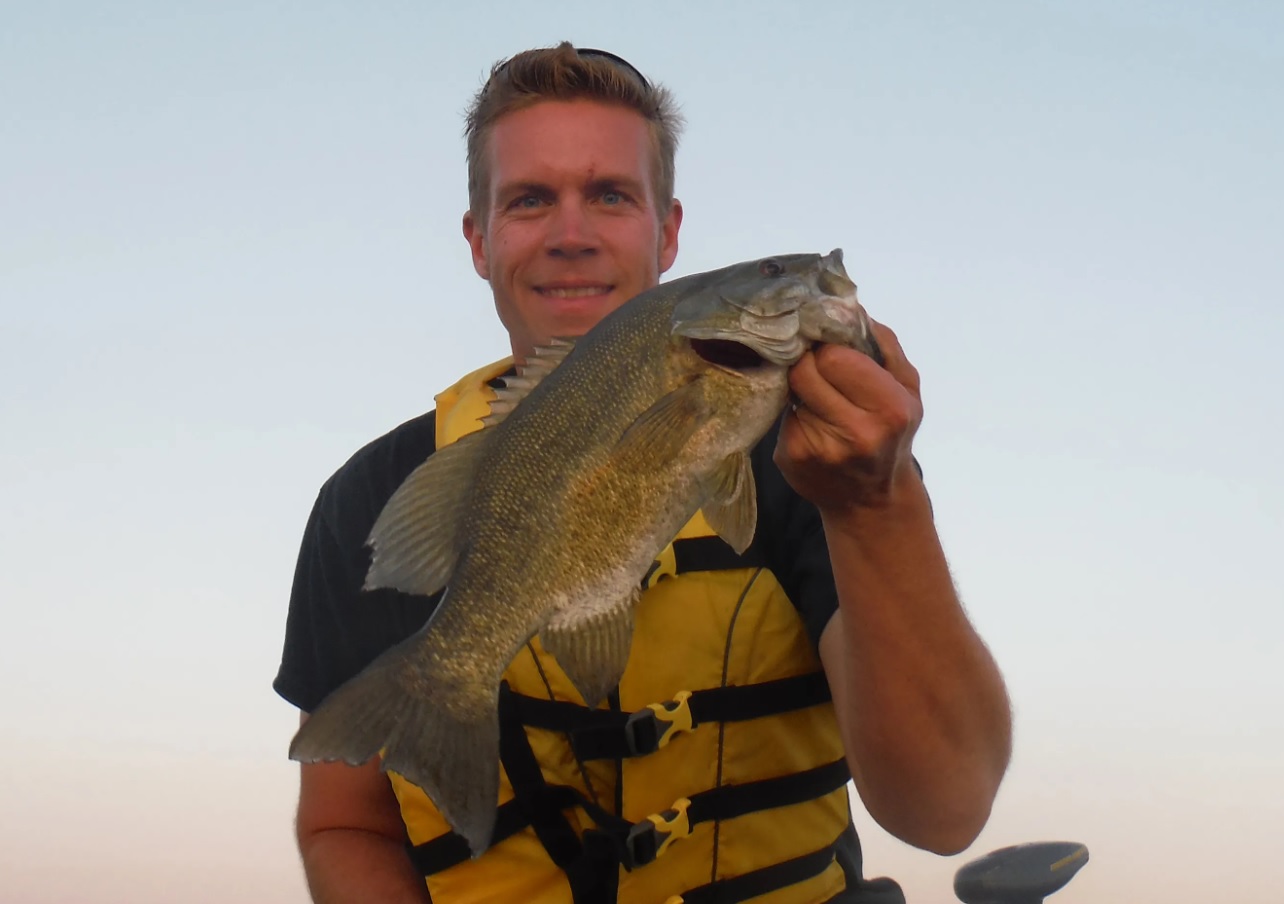
The author with a nice spring smallmouth taken off a steep break loaded with timber. Adding structural elements together will make good smallie spaces great! Simonson Photo.
By Nick Simonson
Smallmouth bass in spring stake out premier spawning sites, with the biggest fish getting the best pieces of territory. Typically, the shallows where they make their beds have many structural elements and knowing what to key in on as these fish make their moves will help connect you with more bass this spring. What follows is a super six-pack of smallmouth haunts to explore with your favorite jig, tube or soft plastic this season.
On the Rocks
Areas of rip rap, boulders, and naturally occurring rock are smallmouth magnets. These spaces warm up quickly in the spring sunlight and attract micro-organisms and small aquatic insects along with baitfish and crayfish. As a result, smallmouth bass are drawn to them as well. When smallies have a nice nook between rocks, or an open area of sand or gravel in a stretch of rip rap, they can be found there in spring setting up for the spawn. Cast over these places with cone-head jigs and Texas-rigged plastics rigged with a bullet weight to avoid getting stuck in the small spaces between rocks.
Good Wood
Downed trees and brush, perhaps pulled in and piled up by recent high waters from record spring snowfall and its subsequent melt, also provide cover for pre-spawn smallies and a place to find a break from the current and set up an adjacent spawning site. The wood has plenty of attraction for the food chain elements addressed above and provides enough cover on at least one side for smallmouth to stage against. Aside from snagging on newer branches and bark, be careful casting around limbs and snaggy sections with jigs and soft plastics. Texas rig a plastic stick, like a Senko, to avoid hooking woody obstructions and instead catch fish.
Them’s The Breaks
Anywhere a river or lake rises up from the depths and provides bass with a quick transition from basin to spawning shallows is a good stretch of topography to explore. When fish are pushed deep by spring cold fronts, check the deep side first and then work shallower as things warm again and smallies head back to the shallows. Find points or inside curves that serve as onramps out of the main lake or river channel to adjacent skinny water. Work the bottoms with football jigs and bucktail jigs, and slowly cast countdown-style crankbaits to locate fish that are suspended in the column.
Docked
Any docks that are in the water early, or are hardy, permanent structures that survive the winter and ice off, are worth being cast at from all angles in the early goings, as they provide structure and shade that fish relate to. Additionally, they are a superior ambush point for items of food flowing by in river current or the first baitfish and panfish that come shallow in spring. Cast jigs and tubes around these structures to find smallmouth bass this season.
Bridge the Divide
Bridges of all sizes draw smallies in spring. From the depths around the center pilings where fish can go for cold-front cover and safety in high light hours, to the shallows and debris that usually settles in the shallow corners underneath, every piece of a bridge is worth a cast for smallies. Upstream pilings on rivers tend to hold on to deadfalls, branches and other structure that washes down in spring and provides cover for fish in addition to the concrete supports. Work them over with a drop-shot rig or tube on an insert jighead to trigger wary bass in these locations.
Go With The Flow
Inflowing water is also a key element for spring smallies. Creeks, springs, draws funneling spring rainwater, and even culverts dumping runoff into a main body can pull smallies up shallow as the spawn nears. Work these points of entry over with suspending crankbaits, jerkbaits, and soft plastics in an effort to cover water quickly and connect with fish. Follow up with a slower presentation if a bass bites but the hook doesn’t connect.
Add It Up
The best smallie spots in spring combine some or all of these elements in close proximity to one another. Knowing what to look for and identifying the structure and the other elements that come with fast fishing are points to hang on to in any journal or GPS. Make a note of these six forms of structure and others this spring in relation to the smallies you catch and odds are you can return to those spots year after year around this same time for more spring success with bronzebacks…in our outdoors.
